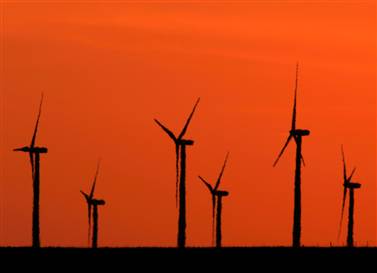MSNBC staff and news service reports
Updated: 8:06 a.m. MT May 3, 2007
WASHINGTON
- Wind farms could generate as much as 7 percent of U.S.
electricity in 15 years, but policymakers need to better
consider the overall impacts, such as the threat spinning
blades pose to birds and bats, a panel of the National
Research Council reported Thursday.
The towers
appear most dangerous to night-migrating songbirds, bats and
some hunting birds, but not enough about the risks is known
to draw conclusions, the experts said in a study requested
by Congress.
Panel
chairman Paul Risser, a professor at the University of
Oklahoma, urged states and local governments to use the
report as a guideline for an "alignment of impacts" that
they weigh when assessing whether and where to site wind
farms.Sources of carbon-free power, wind farms use the wind
to turn giant blades that rotate turbines to make
electricity. The blades have diameters ranging from 230 to
295 feet and are mounted on towers between 197 and 295 feet
tall. Some farms contain hundreds of towers. The one at
Altamont Pass, Calif., has more than 5,000.
Growing
from almost nothing in 1980, wind powered turbines generated
11,605 megawatts of electricity in the United States in
2006, though that was still less than 1 percent of the
national power supply.
Wind farms
now operate in 36 states. The report, which the panel said
was the most comprehensive look at the costs and benefits of
wind power, says estimates are that wind could generate from
2 percent to 7 percent of the nationís electricity within 15
years.
Many
environmentalists and government officials welcome wind
turbines given that they emit no pollutants. Others worry
about the danger to birds and bats, impacts on wildlife
habitat and what some see as a blight on the scenery.
Audubon backs wind, with caveat
Audubon, a national conservation group focusing on birds and
other wildlife, has backed wind power as long as a farm is
properly sited.
The new
report "recognizes that properly sited wind power holds
great promise as a source of renewable energy that can
reduce global warming pollution," Audubon vice president
Betsy Loyless said in a statement. "If we don't find ways to
reduce global warming pollution, far more birds and people
will be threatened by climate change than by wind turbines."
"The first
rule of avoiding negative impacts is a familiar adage:
location, location, location," she added. "It is essential
that industrywide environmental safeguards be developed so
that each wind project can be considered on its own merits
with appropriate studies before and after construction."
Overall,
the report noted that the benefits of wind, such as
reductions in air pollutants, benefit wide areas, while the
environmental costs, such as effects on birds and bats,
occur locally.
The panel
cited estimates of turbine-related bird and bat deaths of
between 20,000 and 37,000 in 2003. Some 9,000 of those were
at the Altamont Pass site.
The
Research Council, an arm of the National Academy of
Sciences, concluded that:
- By the year 2020 wind generators
could offset as much as 4.5 percent of emissions of the
greenhouse gas carbon dioxide from electricity production.
The savings would be less in the mid-Atlantic states where
there is less regular wind.
- In the mid-Atlantic highlands,
preliminary studies indicate that more bats are killed
than expected based on experience with bats in other
regions. There is not enough information to determine
whether the number of bats killed will have overall
effects on populations. However, there has been a
regionwide decline in several species of bats in the
eastern states, so the possibility of population effects
is significant.
- Turbines placed on ridges, as
many are in the mid-Atlantic highlands, appear to have a
higher probability of causing bat fatalities than those at
many other sites.
- At current levels of use, there
is no evidence that fatalities caused by wind turbines
result in measurable demographic changes to bird
populations nationwide, with the possible exception of
raptor fatalities at Altamont Pass, a facility with older,
smaller turbines that appear more apt to kill such birds
than newer turbines are. However, data are lacking for
many facilities.
- While aesthetic concerns often
are the most heard about proposed wind-energy projects,
few decision processes adequately address them.
- Other potential human impacts
include effects on cultural resources such as historic,
sacred, archaeological and recreation sites and the
potential for electromagnetic interference with television
and radio broadcasting, cellular phones and radar.
- Building wind farms requires
clearing land and soil disruption and has the potential
for erosion and noise.
- Regulation of wind farms is a
developing area and better technical guidance to the costs
and benefits needs to be made available. This guidance
could be developed by state and local governments working
with groups composed of wind-energy developers and
non-governmental organizations representing all views of
wind energy, the committee said.
The
National Academy is an independent organization chartered by
Congress to advise the government on scientific matters.
The report
did not examine the impact of offshore wind-energy projects.
The Associated Press contributed to this report.
